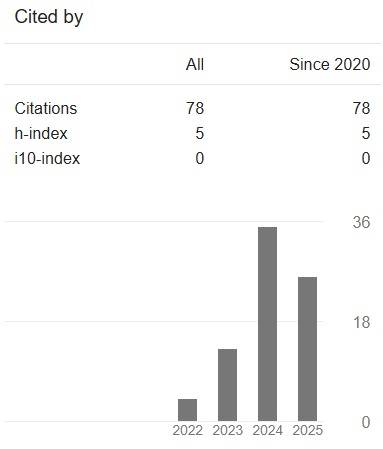Assessing the Impact of Dual Alcohol Blends on Diesel Engine Performance and Exhaust Emissions
DOI:
https://doi.org/10.24191/jaeds.v4i2.85Keywords:
biodiesel, ethanol, methanol, diethyl ethersAbstract
The increasing reliance on diesel fuel has heightened concerns about depleting fossil fuel reserves and environmental impacts. In response, researchers are exploring alternative fuel options, such as blends of alcohol and diesel, to improve sustainability. This study investigates the performance and emissions characteristics of several ethanol, methanol, and diethyl ether (DEE) blends with biodiesel and diesel. The tested fuel blends include B10 (90% diesel, 10% biodiesel), BDE (75% diesel, 10% biodiesel, 15% ethanol), BDE2DEE (75% diesel, 10% biodiesel, 15% ethanol, 2% DEE), BDE5DEE (75% diesel, 10% biodiesel, 15% ethanol, 5% DEE), and MBD2DEE (75% diesel, 10% biodiesel, 15% methanol, 2% DEE). Engine performance was evaluated in terms of brake-specific fuel consumption (BSFC), brake power, exhaust gas temperature, and mass and volume flow rates at varying engine loads. The results demonstrate that fuel blends with diethyl ether, particularly BDE5DEE, exhibited superior performance in reducing emissions. NOx emissions decreased by up to 16.2%, while CO2 emissions were reduced by 15.0%. Additionally, blends with diethyl ether lowered brake-specific fuel consumption by 30.7% compared to standard diesel (B10). The blend MBD2DEE, which includes methanol, delivered the highest brake power at higher loads (75%), peaking at 2.91 kW, indicating its strong potential for high-load applications. These findings suggest that dual alcohol-diesel blends, especially those containing diethyl ethers, offer a promising route for improving fuel efficiency and reducing harmful emissions, making them viable alternatives to traditional diesel fuel.
Downloads
References
G. Labeckas, S. Slavinskas, and M. Mažeika, “The effect of ethanol-diesel-biodiesel blends on combustion, performance and emissions of a direct injection diesel engine,” Energy Conversion and Management, vol. 79, pp. 698–720, Mar. 2014, doi: 10.1016/j.enconman.2013.12.064.
M. I. Gregorio Arenas, M. D. Redel-Macías, A. Ortega, F. R. Lara, and M. P. Dorado, “Alcohol-diesel fuel blends and their effect in performance and exhaust emissions,” Renewable Energy and Power Quality Journal, vol. 1, no. 12, pp. 990–994, Apr. 2014, doi: 10.24084/repqj12.558.
A. O. Emiroğlu and M. Şen, “Combustion, performance and exhaust emission characterizations of a diesel engine operating with a ternary blend (alcohol-biodiesel-diesel fuel),” Applied Thermal Engineering, vol. 133, pp. 371–380, Mar. 2018, doi: 10.1016/j.applthermaleng.2018.01.069.
H. Bayraktar, “An experimental study on the performance parameters of an experimental CI engine fueled with diesel-methanol-dodecanol blends,” Fuel, vol. 87, no. 2, pp. 158–164, Feb. 2008, doi: 10.1016/j.fuel.2007.04.021.
D. H. Qi, H. Chen, L. M. Geng, and Y. Z. Bian, “Effect of diethyl ether and ethanol additives on the combustion and emission characteristics of biodiesel-diesel blended fuel engine,” Renewable Energy, vol. 36, no. 4, pp. 1252–1258, Apr. 2011, doi: 10.1016/j.renene.2010.09.021.
D. H. Qi, L. M. Geng, H. Chen, Y. Z. Bian, J. Liu, and X. C. Ren, “Combustion and performance evaluation of a diesel engine fueled with biodiesel produced from soybean crude oil,” Renewable Energy, vol. 34, no. 12, pp. 2706–2713, Dec. 2009, doi: 10.1016/j.renene.2009.05.004.
D. Agarwal, S. Sinha, and A. K. Agarwal, “Experimental investigation of control of NOx emissions in biodiesel-fueled compression ignition engine,” Renewable Energy, vol. 31, no. 14, pp. 2356–2369, Nov. 2006, doi: 10.1016/j.renene.2005.12.003.
C. D. Rakopoulos, K. A. Antonopoulos, and D. C. Rakopoulos, “Experimental heat release analysis and emissions of a HSDI diesel engine fueled with ethanol-diesel fuel blends,” Energy, vol. 32, no. 10, pp. 1791–1808, 2007, doi: 10.1016/j.energy.2007.03.005.
S. A. Basha, K. R. Gopal, and S. Jebaraj, “A review on biodiesel production, combustion, emissions and performance,” Renewable and Sustainable Energy Reviews, vol. 13, no. 6–7. pp. 1628–1634, Aug. 2009. doi: 10.1016/j.rser.2008.09.031.
A. C. Hansen, Q. Zhang, and P. W. L. Lyne, “Ethanol-diesel fuel blends - A review,” Bioresource Technology, vol. 96, no. 3, pp. 277–285, 2005, doi: 10.1016/j.biortech.2004.04.007.
E. E. Ecklund, R. L. Bechtold, T. J. Timbario, and P. W. Mccallum, “State-of-the-Art Report on the Use of Alcohols in Diesel Engines,” 2018.
K. A. Abed, M. S. Gad, A. K. el Morsi, M. M. Sayed, and S. A. Elyazeed, “Effect of biodiesel fuels on diesel engine emissions,” Egyptian Journal of Petroleum, vol. 28, no. 2, pp. 183–188, Jun. 2019, doi: 10.1016/j.ejpe.2019.03.001.
M. Q. M. Tamam, N. R. Abdullah, W. J. Yahya, H. A. Kadir, Y. Putrasari, and M. A. Ahmad, “Effects of Ethanol Blending with Methanol-Gasoline fuel on Spark Ignition Engine Performance and Emissions,” Journal of Advanced Research in Fluid Mechanics and Thermal Sciences, vol. 83, no. 2, pp. 54–72, 2021, doi: 10.37934/ARFMTS.83.2.5472.
S. A. Shahir, H. H. Masjuki, M. A. Kalam, A. Imran, I. M. R. Fattah, and A. Sanjid, “Feasibility of diesel-biodiesel-ethanol/bioethanol blend as existing CI engine fuel: An assessment of properties, material compatibility, safety and combustion,” Renewable and Sustainable Energy Reviews, vol. 32. pp. 379–395, Apr. 2014. doi: 10.1016/j.rser.2014.01.029.
G. Khoobbakht, M. Karimi, and K. Kheiralipour, “Effects of biodiesel-ethanol-diesel blends on the performance indicators of a diesel engine: A study by response surface modeling,” Applied Thermal Engineering, vol. 148, pp. 1385–1394, Feb. 2019, doi: 10.1016/j.applthermaleng.2018.08.025.
H. Raheman and S. v. Ghadge, “Performance of compression ignition engine with mahua (Madhuca indica) biodiesel,” Fuel, vol. 86, no. 16, pp. 2568–2573, Nov. 2007, doi: 10.1016/j.fuel.2007.02.019.
H. Venu and V. Madhavan, “Influence of diethyl ether (DEE) addition in ethanol-biodiesel-diesel (EBD) and methanol-biodiesel-diesel (MBD) blends in a diesel engine,” Fuel, vol. 189, pp. 377–390, Feb. 2017, doi: 10.1016/j.fuel.2016.10.101.
J. Liang, Q. Zhang, Q. Ma, Z. Chen, and Z. Zheng, “Effect of various ethanol/diesel cosolvents addition on combustion and emission characteristics of a CRDI heavy diesel engine,” Energy Reports, vol. 8, pp. 735–748, Nov. 2022, doi: 10.1016/j.egyr.2021.12.011.
L. Wei, C. Yao, Q. Wang, W. Pan, and G. Han, “Combustion and emission characteristics of a turbocharged diesel engine using high premixed ratio of methanol and diesel fuel,” Fuel, vol. 140, pp. 156–163, Jan. 2015, doi: 10.1016/j.fuel.2014.09.070.
O. Ogunkunle and N. A. Ahmed, “Exhaust emissions and engine performance analysis of a marine diesel engine fuelled with Parinari polyandra biodiesel–diesel blends,” Energy Reports, vol. 6, pp. 2999–3007, Nov. 2020, doi: 10.1016/j.egyr.2020.10.070.
Downloads
Published
How to Cite
Issue
Section
License
Copyright (c) 2024 Muhammad Fairuz Remeli, Muhammad Aiman Hakim Haron, Assoc. Prof. Ir. Dr. Baljit Singh

This work is licensed under a Creative Commons Attribution 4.0 International License.









